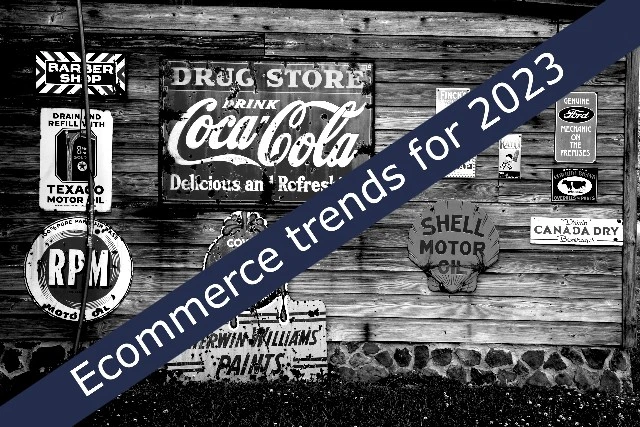What will happen in 2023 for e-commerce, and what is important for your existing and future customers? In this article, I go through my findings and ideas for the coming year regarding trends and needs in online shopping and e-commerce.
By 2025, the fashion industry will hit the $1 trillion dollar mark. That is one thousand billion, or one million times one million. That is a lot of money.
Here is an report on fashion ecommerce value.
And as the turnover increases, so do the different needs of your customers. This will inevitably mean that you need to understand your users' needs and intentions. It should not come as a surprise but still, it is essential to understand this.
So, what kind of intentions and needs are there?
Well, a lot of them actually. That is why I instead like to share my ideas on ecommerce trends for 2023 and onwards. It is easier that way to understand the other aspects of your online business. So let's get right into it.
Omnichannel
It is expected that 2023 will be the year when customers are partly moving back to in-store shopping experiences. But we will not go back to where we were before. We have a need for interactions and a physical shopping experience, but how will this be merged with ecommerce?
Online shopping and sales have declined since the peak back in the first half of 2020 (due to the pandemic). But it remains the biggest point of contact for retailers. With this comes customers' expectations and demands.
This is where omnichannel experiences step in.

You need to understand that the shopping journey doesn’t start (or end) on your website. Your customers are looking for you (and expect you to be) on other platforms as well, like social media, etc. They have a need to feel engaged with your brand and act as brand ambassadors. They will compare reviews and pricing, and tell others about the experience. So, that is the challenge for brands today and in the future.
Here you can read an article on what Omnichannel is.
Choose the right Ecommerce platform
Having the right ecommerce platform for your business is essential for your results. But how do you choose a platform to build your shopping experience on?
Well, not all platforms are for all online shopping sites. I put this list up for you to use as a checklist:
- Does the platform come with a simple and easy-to-use CMS?
- What integrations do they offer?
- Are they API-first?
- Can you access the root files or do they offer affordable developer services?
- Is it easy to connect with your PIM system?
- Where are the servers located?
- Can you handle different markets in the platform?
- Can you grow to new markets seamlessly?
- How about page speed? Ask them for use cases and best cases for their existing clients
Above you have just a few of the things you need to consider and think about when choosing the right ecommerce platform.I know it seems overwhelming, but contact me and I help you on the way.
Subscriptions for Ecommerce
Subscriptions are a growing ecommerce solution that you just can´t oversee anymore.
This solution lets you offer your customers your products on a subscription-based level, meaning they will be recurring customers. Instead of a one-time purchase, you have the possibility to get more customers on a recurring base.
The subscription solution for online stores can be applied to way more products and segments than you first might think. I remember around ten years ago, there was a lot of “buzz” going around about reusing and renting clothes. This is one great idea but still, it has not really grown that much. So, in my opinion, the future for subscription-based ecommercce (and economy) is bright.
The global value of subscriptions in ecommerce is predicted to hit the 120 billion dollars mark this year, 2022, and grow to reach around 900 billion dollars at 2026.
Forbes made research around the growth of ecom and subscriptions, read it here.

Social commerce – is it still a trend?
Do you know what this is? You should.
Social commerce is, as it sounds, selling your services and products right on different social media platforms. This means that your customers actually never leave the platform - all are taking place there. From research to checkout.
Social commerce has been around for quite a while now but is still in its early days. China has come a long way, and the US is speeding up but Europe and the rest of the world are still just getting to know this.
Payment options and methods
Still today, one of the biggest reasons for leaving a shopping cart is related to the payment process.
You should make it simple to complete a purchase AND offer a smooth payment gateway.
Mobile and digital wallets are the most popular payment solution of choice with around 50% of all online store transactions. Here you can read a research on that.
Paypal is still the most popular payment method online, with around 420 million active users, but there are others. One platform that is scaling globally is Klarna.
Recommerce – reused and second-hand selling
Sustainability and CSR work is getting more and more important for customers when they are deciding between brands. This will path the way for re-commerce in the future.
Re-commerce is on the rise. And it will rock the world when it comes to reshaping online shopping in the coming years.
As the future generations (and generation “z”) is more interested in purpose-driven purchases and engagements, the need for having the possibility to make sustainable shopping is increasing. After all, they like to have a world in which they could live.
Personalized shopping experience
As the new generations also are looking for brands that recognize them and give them personalized offers and experiences, they tend to be more willing to pay a bit more for a product or service from someone that they feel connected with. Who doesn´t?
This means that creating a personalized shopping environment for your customers will give you an advantage.
Other outcomes of this are customer loyalty and engagement, and in a longer perspective – your company will grow exponentially

